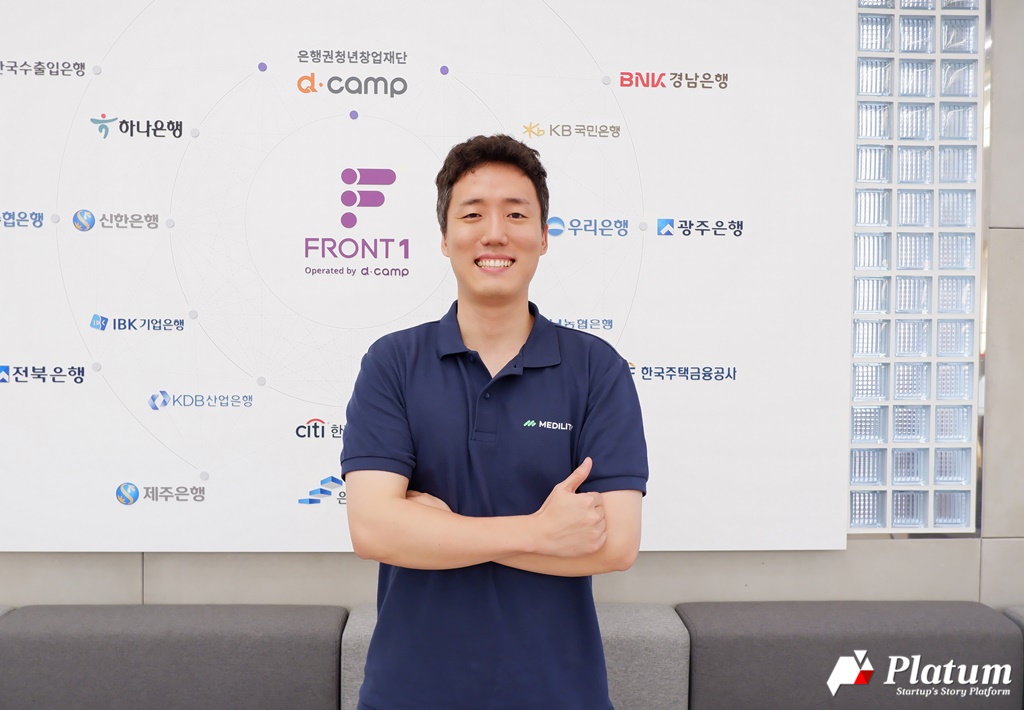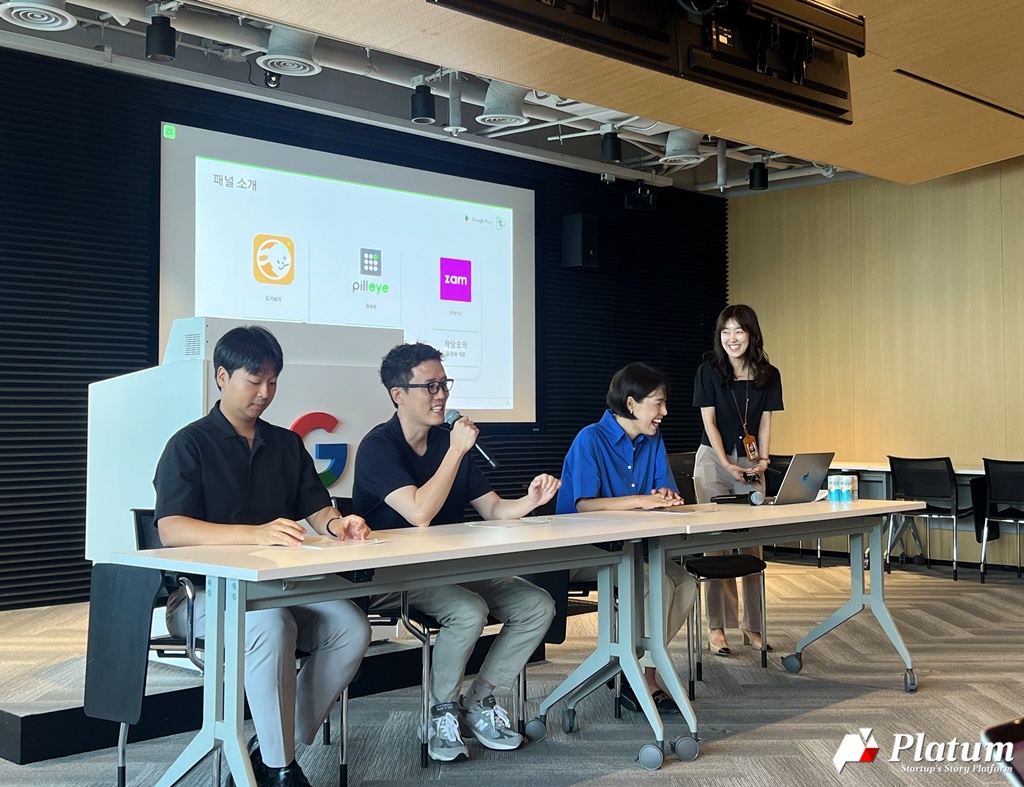“American pharmacists call our app, in short and bold, a ‘life saver.’ Korean pharmacists and hospital pharmacists say, ‘Thank you for saving me from working overtime.’ The most rewarding feedback we received was from a pharmacist at a local pharmacy or hospital who said, “I can focus more on patient care because I have fewer simple, repetitive tasks. That’s why we created the service.” – Sang-eon Park, CEO of Medility
Medility(메딜리티) is an AI-powered pharmacy digital transformation startup that uses artificial intelligence to improve pharmacy inefficiencies. Its flagship service, Pilleye, a pill counting app, can count up to 1,000 pills in a single shot with 99.99% accuracy. It is estimated to have saved over 1.3 million hours of time for healthcare providers who would otherwise have to count pills by hand. As of July of this year, Pilleye has more than 400,000 subscribers in 225 countries worldwide and more than 150,000 monthly active users. In recognition of its growth, the company has raised $5.6 million in pre-A funding from multiple VCs.
As a former pharmacist, Park explained why he started the company, the importance of counting pills in a pharmacy, and what digital transformation means for pharmacies. We caught up with Mr. Park to find out.

Before founding the company, you ran pharmacies in Gumi and Seoul.
I studied pharmacology in college and ran a pharmacy with a partner in Gumi, Gyeongsangnam-do. We had good sales and stable operations, but I wanted to try working in the Seoul metropolitan area, so I bought a two-story pharmacy in Seoul and found that the internal operation process was very disorganized. There was no shortage of workers, but there were inefficient operating systems, such as the location and movement of departments. It took 45 minutes to produce a pediatric drug and get it out the door. After a month of operation, we calculated the operating profit and realized that we would go bankrupt.
Since I had created the operating system when I ran a pharmacy in Gumi, I wanted to change it in Seoul. I redecorated the interior, moved the dispensary from the second floor to the first floor, and rearranged the equipment to accommodate the movement of employees. I automated everything that could be automated and eliminated administrative functions that I thought were unnecessary. As a result, patients received their medications faster, and our operating profit increased tenfold from the time of the acquisition.
You were already running a successful pharmacy when you decided to start a startup. What was your motivation?
I didn’t start with the idea of starting a startup. I’ve always wanted to efficiently change the unnecessary repetitive tasks of pharmacies and pharmacists, and I saw pill counting as the first problem to solve. Pictures taken with smartphones can be recognized, categorized, and even saved regardless of facial expressions, so why couldn’t pills be identified? There were counting apps on the app market, but they weren’t good enough to use, so I decided to make my own.
The same day I had the idea, I posted a message on Soomgo, a platform for matching requesters and experts, “I want to build something like this with AI and I’m looking for someone to teach me the basics. Luckily, a few people replied, and I started learning Python from one of the AI engineers. I had learned C as a kid, so it was pretty easy to learn. That’s where I started.
You started building services as you learned. How did you build your first service?
I realized that I could build a better service by collaborating rather than by doing it alone. So, I approached an AI engineer I met through Soomgo, who was teaching me, and suggested that we build a pill-counting solution together, and he agreed. He would focus on development and I would take care of everything else. It was like a PM (Product Manager) or PO (Product Owner) role. I was so excited when the first app was finished. It was a hugely cathartic to see it come to fruition after all the work of preparing materials, training, etc. It’s probably one of the reasons I still do it today.
What was the app’s counting accuracy at the time. Was it satisfactory, and if not, how did you improve it? When did you get the results you wanted?
It was around 90.0%, which is actually a meaningless number given the specificity of medicine. So, together with our developers, we calculated how much accuracy we could get by increasing the training data and concluded that 92-93% was the maximum. At the time, I posted my app development diary to the pharmacy community, and they said, “We need to get to 99% before we can use it. Personally, I thought 95% would save me a lot of work, but the users’ standards were higher than I thought, and I decided we couldn’t release it at that point.
As an alternative, the engineer suggested that we change the direction of development to hardware. The main reason for the lack of accuracy was that there are too many different environments and situations when taking a photo, and it’s hard to react to all of them. The idea was that if they moved to hardware, they could take pictures of the pills in a controlled environment and apply an AI model to the situation, they could get over 99% accuracy. However, hardware requires design, manufacturing, production, mass production, testing, molds, and other issues, so they felt it was too early for a small company. So they decided to focus more on improving pill counting results in software.
I analyzed the results and found that counting a small number of pills was very accurate. So we hypothesized that if we could train multiple models to predict pill photos, we could improve the accuracy of counting large numbers of pills. When we trained them, the accuracy increased dramatically to 98.7%. We weren’t at product-market fit (PMF) yet, but we saw the potential. The next step was to iterate. There were still a lot of exceptions, and we kept improving as we tested different model approaches.
Eventually, after about a year and a half, we got to 99.2% accuracy. We announced the news to the community, and pharmacists embraced it. It quickly spread by word of mouth, and the service, Pilleye, and the startup, MEDILITY, were born. The name MEDILITY is a combination of the words medicine and utility.
It’s one thing to have an idea, it’s another to actually develop and implement it. What was the most challenging aspect of developing the first service?
MEDILITY is a first mover. Being the first is both an advantage and a disadvantage, because there is no guarantee that what you do will work. When we started, we weren’t sure we had the precision to make it work in the market, so every time we encountered a problem, we worried a lot, but we kept going with the hope that we could do a little more.

What was the reaction around you when you announced that you were launching a startup? You went from a stable area to an area with a lot of variables.
I didn’t get a lot of support. (Laughs) For me, starting a company is a big investment of my time and effort, so it was worth it. The only thing was the timing, it was about 100 days after the birth of our first child, but fortunately my wife believed in me and encouraged me to give it a try. That was a big help.
A small startup is lucky to have great talent. How did you build the team?
Our first developer left for a big company and we wished each other good luck and parted ways. I was looking for an engineer to join us on a recruiting platform, but I couldn’t find anyone, and I didn’t think anyone would be willing to come to a small startup with no investment. Grasping at straws, I posted a job on an anonymous message board on a community site I frequent, and a few people contacted me. That’s how we built our team, and most of the people who joined us are still with us today. One in particular is now an integral part of the company. In a way, it was an incredibly lucky team build.
You can’t just chalk it all up to luck. I’m sure you got good people on board because you were persuasive.
I think it’s the same with investors and team members. Venture capitalists are making a financial investment in the company, and team members are making a time commitment, so you have to make sure they understand that this business is realistic, what the future holds, and who the CEO is. So we really tried our best to do IR for every single team member, every single person that we hired. And that continues to this day.
Startups are always understaffed, but we can’t just pick and choose. Do you have your own hiring criteria?
One of my favorite books is “How Google Works” by Eric Schmidt, and the core of it is: “Hire the best people and create an environment where they can excel. That’s how we work at MEDILITY.
When it comes to hiring talent, one of the most important things is to never compromise. In early-stage startups, if you don’t have an engineer, you’ll hire someone with a certain functional fit. That’s understandable, and it can be a realistic fit. But we don’t let go of a functional fit if it’s not a cultural fit.
What is the culture at MEDILITY and what does the best person for the company look like? A team of specialists doesn’t necessarily make a good team…
MEDILITY is a very autonomous company. You decide what you do, how many hours you work, where you work, etc. We believe that providing an environment where you can focus on your work is the best benefit a company can offer.
The best people are those who have a fast growth curve in their position, even if it’s at a junior level. In a startup, you have to keep learning new things as the company grows. We look for people who can absorb that quickly. There’s nothing to say about seniority in terms of functionality. It’s more about being a good influence and helping the junior and mid-level engineers around you grow.
And it should be someone who has accomplished what they set out to do. I believe that people who have seen something through to the end have the ability to solve problems. Startups are like professional football teams. In professional soccer, the coach doesn’t give any instructions during the game, and the players make their own moves according to the situation.
At MEDILITY, we pride ourselves on having the best talent, and our team members actively seek out the best talent to protect themselves and their jobs. They feel that in order for MEDILITY to remain a good company, we need to keep bringing in new talent.
The reason we hire the best people and create the culture we do is because we need to be successful. To do that, we need to have great products. Great products require great product skills, and I think the best skills come from great team members and a great culture. Startups stop growing when they stop growing[AR1] . It’s the people that keep the company going.
How are employees evaluated and what is the compensation policy?
At MEDILITY we don’t set individual OKRs (Objectives and Key Results). There are only organizational goals and the rest is up to the individual. There are no HR reviews, but there are adjustments as individuals improve. The compensation policy is like any other early-stage startup: stock options. We have a clearly delineated stock option pool that will not be depleted as we move to a later stage.
Rewarding people with stock options is essential. But it’s inevitable that the motivation will wear off after a while. Employees are more motivated when they see that their contributions and services have a positive impact on the world. MEDILITY’s business is aligned with this motivation.
Unless we’re God, we can’t just find the people we want. We can’t find the people we want unless we are gods. [AR2] It’s simply the opinion of the employees as to whether they want to work together. That’s how MEDILITY continues to maintain a high level of organizational culture, and it works really well.
As your team grows, so should you. What are your efforts as CEO and the challenges of running a company?
We try to grow in different ways to increase our capabilities. My background before starting a startup was running a pharmacy, so I always think I need to learn a lot. As the company grows, I try to anticipate the role of the CEO and build my capabilities in advance. I learn a lot from great advisors, especially angel investors and VCs.

Let’s talk ‘Pilleye’. What does it mean for healthcare workers to have to count pills accurately? What are the pain points?
You can think of Pilleye as the service for everything related to medicine. Our most popular customers are pharmacists, both local and international. And nowadays veterinary clinics use it a lot. Some pharmaceutical companies use it for QA (quality assurance), and Incheon Customs uses it to seize drugs.
The pain point in pharmacies is that it takes too long to count pills. If you’re not in the industry, you might think why count pills, but it’s a basic task in a pharmacy. Let’s say you have a bottle of 1000 pills, and if it’s open, even one or two pills can get lost, so you need to make sure you’re counting them correctly.
You also need it to fill prescriptions. Usually for things like constipation medication, you get a prescription for six months or a year at a time, and you need 300 pills, which you take out of the big bottle and count them one by one. It’s simple, but it’s very important because you don’t want to be wrong. Before Pilleye, the only way to do that was to count them one by one.
You have been actively using AI to develop services since the beginning of my company.
When I first planned my service, AI was not as common as it is now, and its performance was not as high. The technology recommended by many experts at that time was OpenCV (Open Source Computer Vision), an image processing algorithm. However, pills are often lying down, standing at an angle, or cut in half. There are many different environments and backgrounds. You can take a picture of a pill on a white desk, on a black floor, or with all the lights off. Especially with a white pill on a white desk, it’s really hard to distinguish between the pill and the desk. If the pills are transparent, the color of the pills can change depending on the background. So I thought it was difficult to handle these different situations with OpenCV, so I had to solve it with AI that can learn realistically.
The medication prescribed to a patient would only be meaningful if the count was accurate enough to be close to 100%. How do you continually improve to achieve this? It sounds like data quality is very important to you.
It doesn’t end with the launch of the product. It’s been two years and eight months since we launched, and AI learning is still an ongoing process. MLOps (machine learning operations) are also constantly improving. Because we operate overseas, we get anomalies all the time that we didn’t even think about. We are constantly reducing them through post-processing.
Pilleye is used in more than 230 countries around the world, not just in South Korea. How have you approached international expansion?
I think it’s because the product itself is simple and effective. Counting pills is a problem that exists in pharmacies all over the world, and our service works well, so it spread. It’s a myth that marketing alone will drive sales or success if the market fit is not right.
When we built the product, we tried to get the word out on Reddit and in the pharmacy community. It was a service that solved their problem, so it spread quickly. From the beginning, we also paid attention to SEO (search engine optimization) so that we could be found well when people searched for us. We wanted to be at the top of searches for “pill counting” or “pill count”. If you look at the search stats, 98% of people come from Google or word of mouth. It’s a combination of community, market fit, and high search rankings.
Recently, our MAU (Monthly Active Users) on the Taiwan side went through the roof. It went from 10 to 3,000 in one month, and I didn’t even know there was a market in Taiwan. It turned out that a famous Taiwanese influencer, a pharmacist, was constantly posting about using our service on his Instagram story. I even sent him a DM to thank him. (laughs)
From which countries do you see the best response and why?
The best response has been in the USA. In Korea, the pills are packaged in single doses in pouches, whereas in the U.S. it’s more common to see them in small tubs. Inventory is also much higher than in Korea.
You sell a special tray for the Pilleye app. This is a new piece of hardware that you didn’t have access to early on.
The design is patented, and it’s actually popular as a gift for opening a pharmacy. (laughs) That was possible because a lot of pharmacists are now using the Pilleye app.
You must have encountered a lot of different situations while running your business, do you have any memorable stories?
I had the opportunity to meet a user and talk to him. He worked in a hospital pharmacy and he said that once a month he had to work 10 hours with 10 people to do an inventory. He told me that since his team started using our app, their resources have been cut in half. The day of the inventory was a night shift and he and his team were so happy to be able to leave on time and thanked us for allowing them to focus more on their patients. That’s what we’re in this business for.

MEDILITY is driving the digital transformation of pharmacy practice. Why does pharmacy need digital transformation? How will pharmacists’ roles change in the future?
Much of what pharmacists have done in the past has been simple and repetitive. Two-thirds of their time is spent on what we call menial tasks, and one-third is spent at the front desk interacting with patients. So there are analysts who say that if AI takes over these simple, repetitive tasks, a lot of pharmacists will lose their jobs.
I think that’s half right and half wrong. The digital healthcare sector is evolving very rapidly in the wake of the Fourth Industrial Revolution. Digital therapies, wearable devices and genetic testing are on the rise. But I don’t think every consumer is capable of using them without expert help. Some people are, but they’re not the only ones in society. There are many patients who need the help of a pharmacist.
We think pharmacists are very capable. It hasn’t been recognized because they haven’t had the opportunity to contribute to society, and there’s too much work behind the scenes. We believe that if we take away the menial tasks, pharmacists will spend their time on much more valuable tasks. It would make more sense for society if solutions like Pilleye could eliminate low-value tasks and allow pharmacists to focus more on patient care as healthcare professionals.
Pharmacists in Japan and the United States are very active as health care professionals. In the United States, pharmacy schools teach the value of the pharmacist as “the most accessible health care professionals.” For example, in the United States, pharmacists provide prescription interventions when elderly patients have to go to multiple hospitals to pick up medications. Doctors can’t see them all, and pharmacists can do it themselves because they are the experts on the medications. In Japan, for example, pharmacists do the opposite, traveling to patients when they need a visit. In these developed countries, pharmacists play a role as healthcare professionals. Korean pharmacists need to read and prepare for this trend.
The company recently closed a KRW 5.6 billion ($4.2 million) investment. That’s a lot of money for a pre-A round. Based on your experience, what advice would you give to startups preparing to raise money?
The act of IR is about resonating with VCs and getting what you want. Then you have to follow their grammar to the letter. If you approach it casually, you’re likely to expend energy and end up with nothing. Be thorough and show them your metrics in their preferred grammar and the rationale behind your efforts to create them.
VCs measure teams in many different ways. But at the end of the day, it’s all about multiple returns. IR is about telling the story that the company or service will be bigger later than it is now, and that it’s going to do really well in the near future. VCs are looking for a 10x or 100x return on their investment, and they’re thinking about what kind of traction they need to get to that valuation. Startups need to be able to show the milestones they need to get there, and what’s been accomplished, what’s going to happen, and what it looks like in its finished form. The story around it should be compelling.
What are the company’s short-term goals and where does Medility see the business going?
One of the most frustrating tasks for pharmacists is checking drug packaging. We’re trying to create a solution that makes it easier. The ultimate goal is to create a digital transformation of pharmacy operations. I envision every pharmacist using the MEDILITY suite, just like Google Workspace or Microsoft Office.
Do you have any final thoughts or comments you’d like to share? I’ll definitely incorporate them.
If I could, I would say one thing. “Thank you, honey, for believing in me. I love you so much!”







Leave a Comment